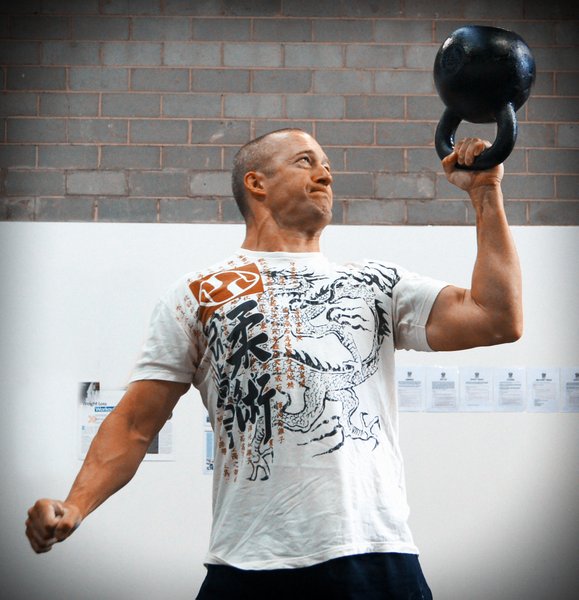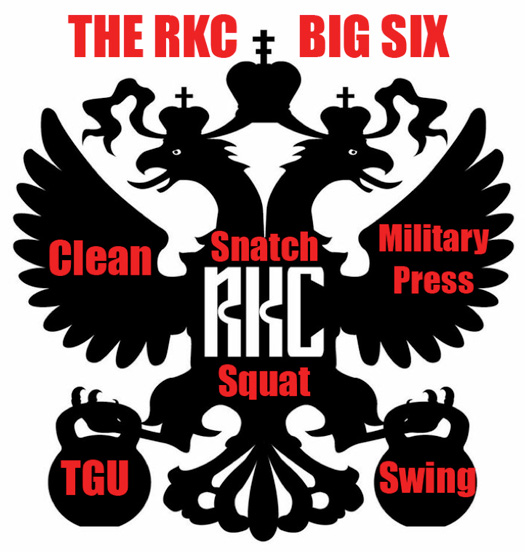
The learning and skill continuum that begins at HKC and progresses through RKC and RKC-II follows a fairly straight line. We begin with patterning exercises in HKC—two hand swings, the goblet squat, and the get-up—before progressing to one handed variations on these themes such as the clean and snatch, and the double kettlebell front squat at the RKC. The work done on the get-up lends itself to pressing and snatching which in turn leads to the double push press and jerk as well as the windmill and the bent press at RKC-II.
At RKC-II, people usually face one of two problems, either their thoracic mobility is poor and they struggle with the double overhead work (as well as the windmill and bent press) or they struggle to get their heavy press. As much as the old RKC saying, “To press a lot, you must press a lot” does ring true for many, it may also lead to bigger problems down the line.
About a year ago I wrote an article for Breaking Muscle (Single Kettlebell Ballistic Complexes: How to Save Your Shoulders and Still Work Overhead) which explained the three different types of AC joint set up that people have, as well as possible ways to train long term without damaging yourself. But that still doesn’t help us with the heavy press goal if we’re on our way to RKC-II, does it?
When I wrote Beast Tamer, I outlined many different press plans that could help you get through a sticking point in your press training. I’ve learnt a bit since then and want to outline a plan below that will help you get through your sticking points without risking injury.
What we need is a drill that gives us the same feel as the heavy press and the same effort—all without placing the same strain on the AC joint. This is where the bottoms-up press (BUP) comes into play. The BUP is an interesting drill. Interesting in that I have used it as a one-size-fits-all solution for a variety of problems with the press. Not gripping the kettlebell tightly? The BUP will fix that. Not staying tight in your press? The BUP will fix that too.
The BUP is ideal for our needs as it teaches great form while forcing you to use less load. That may sound problematic, but the body doesn’t register how much you lift, only how much tension you generate. If your form is even slightly off, the kettlebell will fall. This is what makes the BUP ideal as a learning tool. It is automatically apparent what needs to happen and where the point of failure is.
Imagine that the fulcrum (center of rotation) for this movement is not the delicate AC joint, but instead a point midway between the deltoid and the elbow—essentially the middle of the bicep. By focusing on having your elbow move around that point while doing a BUP you will teach your whole body to engage during the press. Likely you will find this feels significantly different to what you have been doing when overhead pressing.
One of the things to keep in mind in relation to the BUP, is that it has a great effect up to a point. I don’t believe that past 32kg they do much to boost your press as the skill becomes its own lift. Prior to that they can be a valuable tool to teach you tension and alignment. Do not make the mistake of turning the drill into an exercise. The goal is never to have the best BUP in the world, rather to use the BUP to build your press.
Low reps are a must with the BUP, as the CNS fatigue from the high grip demand is intense. 2-3 sets of 3-5 reps seem to work best prior to your limit presses for the day.
The other side of this equation is that healthy shoulders are not built from pressing alone. For every push, you must have at least one set of pulling to counteract it. While the pull up is usually the choice of functional trainers, I’ll caution against it as the lat also acts as an internal rotator of the arm, so if all you do are presses and pull ups you’re just as likely to end up with bad shoulders as if you only did presses.
At RPT, we use a variety of weighted mobility drills to achieve healthy shoulders. Here’s how a press workout might look:
Lying dislocates with weight – 3 sets of 10 reps. Paired with push-ups for 3 sets of 10-20 reps.
BUP – 2 x 5 at 50%
Y-T-Row – 2 x 5-5-10
BUP – 3 ladders of 1-2-3 reps combined with easy light two-hand swings in between to help shake the tension out.
Perform a rear support—think of it as a face up plank—for 60 seconds and then do a get-up on each side. Perform three super sets of this as a final shoulder health practice. Make sure to stretch after and “unglue” all the tension you’ve built up in these muscles during training. Pay particular attention to the triceps, lats, traps, and shoulders.
***
Andrew Read, Master RKC, Author of Beast Tamer, is head of Dragon Door Australia and Read Performance Training. Recognized as Australia’s leading functional strength trainer he is a regular contributor to Blitz, Inside MMA, International Kickboxer, Oxygen, Ultrafit and Breaking Muscle. His coaching background spans nearly twenty years having worked with many Olympic and world championship level athletes.
